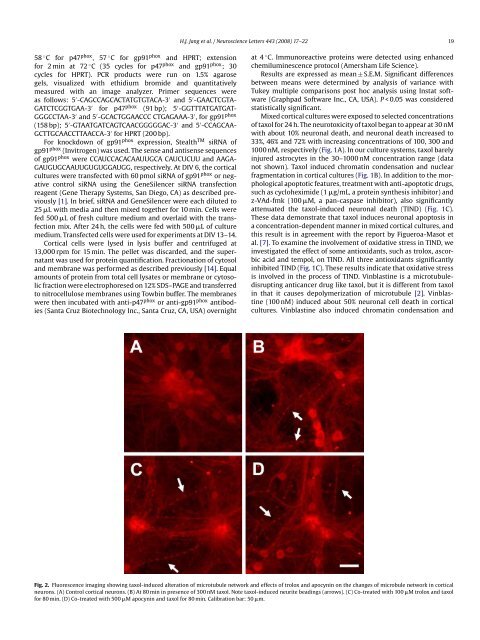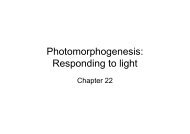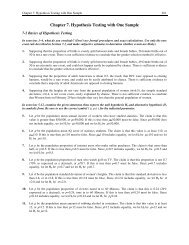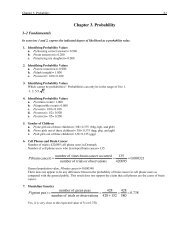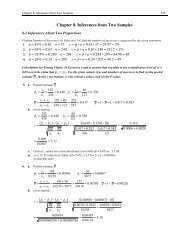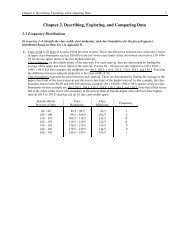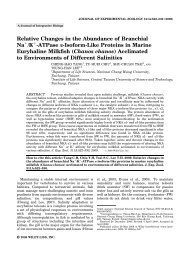Targeting cyclin B1 inhibits proliferation and sensitizes breast ...
Targeting cyclin B1 inhibits proliferation and sensitizes breast ...
Targeting cyclin B1 inhibits proliferation and sensitizes breast ...
You also want an ePaper? Increase the reach of your titles
YUMPU automatically turns print PDFs into web optimized ePapers that Google loves.
H.J. Jang et al. / Neuroscience Letters 443 (2008) 17–22 1958 ◦ C for p47 phox , 57 ◦ C for gp91 phox <strong>and</strong> HPRT; extensionfor 2min at 72 ◦ C (35 cycles for p47 phox <strong>and</strong> gp91 phox ; 30cycles for HPRT). PCR products were run on 1.5% agarosegels, visualized with ethidium bromide <strong>and</strong> quantitativelymeasured with an image analyzer. Primer sequences wereas follows: 5 ′ -CAGCCAGCACTATGTGTACA-3 ′ <strong>and</strong> 5 ′ -GAACTCGTA-GATCTCGGTGAA-3 ′ for p47 phox (91 bp); 5 ′ -GGTTTATGATGAT-GGGCCTAA-3 ′ <strong>and</strong> 5 ′ -GCACTGGAACCC CTGAGAAA-3 ′ , for gp91 phox(158 bp); 5 ′ -GTAATGATCAGTCAACGGGGGAC-3 ′ <strong>and</strong> 5 ′ -CCAGCAA-GCTTGCAACCTTAACCA-3 ′ for HPRT (200 bp).For knockdown of gp91 phox expression, Stealth TM siRNA ofgp91 phox (Invitrogen) was used. The sense <strong>and</strong> antisense sequencesof gp91 phox were CCAUCCACACAAUUGCA CAUCUCUU <strong>and</strong> AAGA-GAUGUGCAAUUGUGUGGAUGG, respectively. At DIV 6, the corticalcultures were transfected with 60 pmol siRNA of gp91 phox or negativecontrol siRNA using the GeneSilencer siRNA transfectionreagent (Gene Therapy Systems, San Diego, CA) as described previously[1]. In brief, siRNA <strong>and</strong> GeneSilencer were each diluted to25 L with media <strong>and</strong> then mixed together for 10 min. Cells werefed 500 L of fresh culture medium <strong>and</strong> overlaid with the transfectionmix. After 24 h, the cells were fed with 500 L of culturemedium. Transfected cells were used for experiments at DIV 13–14.Cortical cells were lysed in lysis buffer <strong>and</strong> centrifuged at13,000 rpm for 15 min. The pellet was discarded, <strong>and</strong> the supernatantwas used for protein quantification. Fractionation of cytosol<strong>and</strong> membrane was performed as described previously [14]. Equalamounts of protein from total cell lysates or membrane or cytosolicfraction were electrophoresed on 12% SDS–PAGE <strong>and</strong> transferredto nitrocellulose membranes using Towbin buffer. The membraneswere then incubated with anti-p47 phox or anti-gp91 phox antibodies(Santa Cruz Biotechnology Inc., Santa Cruz, CA, USA) overnightat 4 ◦ C. Immunoreactive proteins were detected using enhancedchemiluminescence protocol (Amersham Life Science).Results are expressed as mean ± S.E.M. Significant differencesbetween means were determined by analysis of variance withTukey multiple comparisons post hoc analysis using Instat software(Graphpad Software Inc., CA, USA). P < 0.05 was consideredstatistically significant.Mixed cortical cultures were exposed to selected concentrationsof taxol for 24 h. The neurotoxicity of taxol began to appear at 30 nMwith about 10% neuronal death, <strong>and</strong> neuronal death increased to33%, 46% <strong>and</strong> 72% with increasing concentrations of 100, 300 <strong>and</strong>1000 nM, respectively (Fig. 1A). In our culture systems, taxol barelyinjured astrocytes in the 30–1000 nM concentration range (datanot shown). Taxol induced chromatin condensation <strong>and</strong> nuclearfragmentation in cortical cultures (Fig. 1B). In addition to the morphologicalapoptotic features, treatment with anti-apoptotic drugs,such as cycloheximide (1 g/mL, a protein synthesis inhibitor) <strong>and</strong>z-VAd-fmk (100 M, a pan-caspase inhibitor), also significantlyattenuated the taxol-induced neuronal death (TIND) (Fig. 1C).These data demonstrate that taxol induces neuronal apoptosis ina concentration-dependent manner in mixed cortical cultures, <strong>and</strong>this result is in agreement with the report by Figueroa-Masot etal. [7]. To examine the involvement of oxidative stress in TIND, weinvestigated the effect of some antioxidants, such as trolox, ascorbicacid <strong>and</strong> tempol, on TIND. All three antioxidants significantlyinhibited TIND (Fig. 1C). These results indicate that oxidative stressis involved in the process of TIND. Vinblastine is a microtubuledisruptinganticancer drug like taxol, but it is different from taxolin that it causes depolymerization of microtubule [2]. Vinblastine(100 nM) induced about 50% neuronal cell death in corticalcultures. Vinblastine also induced chromatin condensation <strong>and</strong>Fig. 2. Fluorescence imaging showing taxol-induced alteration of microtubule network <strong>and</strong> effects of trolox <strong>and</strong> apocynin on the changes of microbule network in corticalneurons. (A) Control cortical neurons. (B) At 80 min in presence of 300 nM taxol. Note taxol-induced neurite beadings (arrows). (C) Co-treated with 100 M trolox <strong>and</strong> taxolfor 80 min. (D) Co-treated with 500 M apocynin <strong>and</strong> taxol for 80 min. Calibration bar: 50 m.


